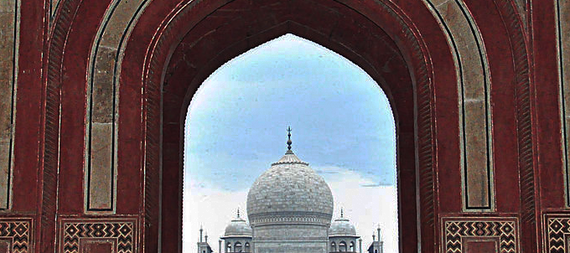It took Shah Jahan 17 years to build the iconic Taj Mahal, a mausoleum for his wife Mumtaz, who died during childbirth in 1631. A structure known as the testament of true love for centuries has also been the cause of both pride and controversy in equal measure for India. If you walk around it, you will see that its four facades are identical, with vaulted arches and quotes from the Holy Quran inlaid onto the marble.
Image may be NSFW.
Clik here to view.
This is because the Mughals considered symmetry symbolic of balance and harmony in their empire. But, as Dr. Dilip Ahuja proves through his research and tells us in the podcast, it's not as perfect as it seems. So, was the iconic monument created with a single error on purpose? Or, did the artists and craftsmen make an honest mistake because of a lack of advanced scientific equipment? Did Shah Jahan know? The answers to these questions are hidden in the legends that surround the history of the building -some that tell of Shah Jahan cutting off the hands and gouging out the eyes of artists who built it and others of how he wanted to build a black version of the Taj Mahal for himself.
A total of Rs 32 million (today's equivalent of Rs 53 billion) was spent on constructing the Taj; it was made with makrana marble from Rajasthan, lapis lazuli from Central Asia and turquoise from Tibet, and it is said that 1,000 elephants were required to transfer these materials all the way from their homes to Agra. But, this luxury also put the Taj at risk once the Mughal Empire collapsed in the 18th century. The Jats (a Hindu community from North India), looted it in 1964 and stripped it of its two silver doors. British colonisers plundered it for the hand-woven carpets and precious gems, but Lord Curzon the viceroy of India from 1899 to 1905, ordered the restoration of the historical site and its gardens. He also gifted the Taj with a grand chandelier, which unfortunately, came crashing down in August 2015 and is currently being restored.
Today, Agra has transformed from being a Mughal Capital to an economically advanced city, the industrialisation and resulting pollution leading to the yellowing of the Taj's pristine white marble. The monument has since gotten a beauty treatment of sorts - workers applied Fuller's Earth (yes, that pack of multani mitti in your fridge was good enough for the Taj too!) to its walls and washed it off after 24 hours, a process that helped restore its sheen. The Supreme Court of India has prohibited the construction of any building that might obscure the view of the Taj Mahal, so that we can enjoy its beauty from a distance, just like Shah Jahan did when he was imprisoned in Agra Fort, for years till he died.
Image may be NSFW.
Clik here to view. Like Us On Facebook |
Like Us On Facebook |
Image may be NSFW.
Clik here to view. Follow Us On Twitter |
Follow Us On Twitter |
Image may be NSFW.
Clik here to view. Contact HuffPost India
Contact HuffPost India
Also see on HuffPost:
Image may be NSFW.
Clik here to view.

This is because the Mughals considered symmetry symbolic of balance and harmony in their empire. But, as Dr. Dilip Ahuja proves through his research and tells us in the podcast, it's not as perfect as it seems. So, was the iconic monument created with a single error on purpose? Or, did the artists and craftsmen make an honest mistake because of a lack of advanced scientific equipment? Did Shah Jahan know? The answers to these questions are hidden in the legends that surround the history of the building -some that tell of Shah Jahan cutting off the hands and gouging out the eyes of artists who built it and others of how he wanted to build a black version of the Taj Mahal for himself.
A total of Rs 32 million (today's equivalent of Rs 53 billion) was spent on constructing the Taj; it was made with makrana marble from Rajasthan, lapis lazuli from Central Asia and turquoise from Tibet, and it is said that 1,000 elephants were required to transfer these materials all the way from their homes to Agra. But, this luxury also put the Taj at risk once the Mughal Empire collapsed in the 18th century. The Jats (a Hindu community from North India), looted it in 1964 and stripped it of its two silver doors. British colonisers plundered it for the hand-woven carpets and precious gems, but Lord Curzon the viceroy of India from 1899 to 1905, ordered the restoration of the historical site and its gardens. He also gifted the Taj with a grand chandelier, which unfortunately, came crashing down in August 2015 and is currently being restored.
Today, Agra has transformed from being a Mughal Capital to an economically advanced city, the industrialisation and resulting pollution leading to the yellowing of the Taj's pristine white marble. The monument has since gotten a beauty treatment of sorts - workers applied Fuller's Earth (yes, that pack of multani mitti in your fridge was good enough for the Taj too!) to its walls and washed it off after 24 hours, a process that helped restore its sheen. The Supreme Court of India has prohibited the construction of any building that might obscure the view of the Taj Mahal, so that we can enjoy its beauty from a distance, just like Shah Jahan did when he was imprisoned in Agra Fort, for years till he died.
Image may be NSFW.
Clik here to view.
 Like Us On Facebook |
Like Us On Facebook | Image may be NSFW.
Clik here to view.
 Follow Us On Twitter |
Follow Us On Twitter | Image may be NSFW.
Clik here to view.
Also see on HuffPost:
